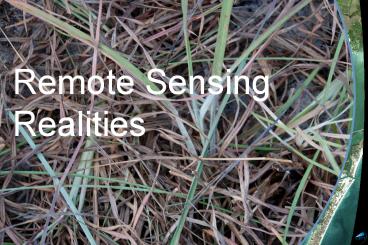Remote Sensing Realities - PowerPoint PPT Presentation
1 / 9
Title:
Remote Sensing Realities
Description:
Remote Sensing Realities Bumps you ll run into along the way Different data formats For Landsat this is being standardized to L1T GeoTIFFs Different projections ... – PowerPoint PPT presentation
Number of Views:39
Avg rating:3.0/5.0
Title: Remote Sensing Realities
1
Remote Sensing Realities
2
Bumps youll run into along the way
- Different data formats
- For Landsat this is being standardized to L1T
GeoTIFFs - Different projections
- For Landsat this is being standardized to UTM
- Topographic distortions
- For Landsat all data will soon be Level-1
Terrain-corrected (L1T) - Data availability
- Cloud cover, same season, SLC-off gaps, cost
3
More bumps
- DN v. Radiance v. Reflectance
- TOA Reflectance v. Surface Reflectance
- Difficulty comparing data from different sensors
(MSS, TM, ETM)
4
Whats standing between you and your signal???
- The atmosphere
- Terrain relief
- Season
- Sun angle
- Partial spectral signatures
5
Whats standing between you and your signal???
- Remote sensing data must be corrected for
atmospheric, topographic, and solar effects if
they are to be compared to a library of spectral
reflectance curves. Furthermore, relative
atmospheric correction is needed if data
signatures from one image date are to be compared
to those from another date. - Robert A. Schowengerdt, Remote Sensing Models
and Methods for Image Processing
6
Whats standing between you and your signal???
- A common radiometric response is required for
quantitative analysis of multiple satellite
images of a scene acquired on different dates
with different sensor. - Ideally, you want all image to appear as if they
were acquired with the same sensor while
observing through the same atmosphere and
illumination conditions. - Hall et al., 1991
7
Change Detection Accuracy
- Hinges on
- Precise geometric registration b/w images
- Calibration or normalization between
multi-temporal images - Availability of quality ground truth data
- Complexity of landscape and environs of study
area - Change detection methods or algorithms used
- Classification and change detection schemes
- Knowledge and familiarity of the study area
- Time and cost restrictions
D. Lu et al., 2004
8
A Case Study
- Remote Sensing of Environment article 15 Jan.
2008 - Using long time series of Landsat data to
monitor fire events and post-fire dynamics and
identify driving factors. A case study in the
Ayora region (eastern Spain) - Remote sensing can contribute to the estimation
of fire risk or determination of fuel loads
serve as an input for fire simulation models,
help with fire perimeter mapping and monitoring
of fire-affected area. They looked at a period
from 1972-2000 using MSS, TM and ETM data - Their satellite data pre-processing involved
- radiometric correction of all images to attain
surface reflectance - sensor calibration
- modeling of radiative transfer
- topographic illumination corrections
- atmospheric transmission calculations to account
for different water vapor concentrations
9
iGETT Remote Sensing Goals
- know that federal RS data is out there
- know how to download data
- know how to do basic image manipulation
- understand how data becomes information
- integrate RS information with GIS
- overall goal your students, once in the
workplace, will have had exposure to RS data































